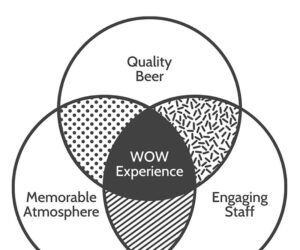Crunching the COGS: When it’s not a hobby anymore

When I was hired by Dogfish Head a decade ago, one of the first trips I took was a research vacation to the Pacific Northwest to immerse myself in and learn as much as I could about the business behind craft beer. I had very few beery numbers peers back then, and most worked for breweries the size of New Belgium, Sierra, and Allagash. I recognized the importance of learning from smaller-scale operations, to understand their growth patterns and costing methodologies, but I needed to build a database in order to map those patterns. Over a period of a week I visited 26 breweries and brewpubs, and the results of my findings were astounding. At that point, 25 of the 26 didn’t know how to cost out one run of their beer. Very few to none were implementing any cost accounting practices, and most were using averages as estimates. Estimates at best. The cash was rolling in, and each was generating enough sales to pay all the bills and payroll, so that was viewed as good enough. Being an accountant, this was a challenging mindset for me to accept. It was also quite eye-opening and provided me the inspiration to eventually launch my own consultancy focused on small-scale operations.
Over the past decade I’ve had many conversations with aspiring brewers as they’ve explored the financial and emotional feasibility of running a nanobrewery. “Could one support oneself and/or his or her family with a 1-BBL or 3-BBL operation in 1,500 square foot (140 sq. m) space?” “Could that 1-BBL brewery grow into a 7-BBL or 10-BBL operation pretty easily with unique branding and quirky styles? Others have done it in the past, so could I?” These brewers would hand me their numbers, and I’d poke holes through their assumptions. Where are the production and taproom losses factored in? Why are you using average cost when the most expensive style will be your flagship? Where are your credit card processing fees? Time and time again full cost has been misunderstood as another startup would venture forth undercapitalized. Small-scale brewers need to understand how to cost not only our beers, but our entire operation as well. Let’s start with the type of costs that fold into each batch we create.
Types of Costs
Within our operation we have fixed costs and variable costs. Fixed costs do not change with our level of production, while variable costs do. Some examples of fixed costs would include our monthly lease of our space, liability insurance, and our head brewer’s salary (unless he/she is paid hourly). Variable costs would include our raw materials (malt, hops, adjuncts), carbonation, and packaging. Some costs are a mix of fixed and variable, such as certain utilities, where you are charged a fixed monthly account fee and a separate usage fee per kilowatt, gallon, etc.
Small-scale brewers need to understand how to cost not only our beers, but our entire operation as well.
All our costs can also be labeled as direct or indirect. Direct costs can be traced back to each batch of beer produced, such as raw materials, which are traced by pounds per batch produced or the head brewer’s salary, which are traced by hours spent brewing each batch. Indirect costs cannot be easily traced back to each batch of beer produced; thus, they are allocated based on a certain level of activity. In most cases in brewing, that activity is number of gallons produced and include such costs as carbon dioxide, which is used in many processes within the brewery, from carbonating our beer within our fermentation vessels (FVs) to moving beer through the lines in the taproom and through our canning line while packaging via mobile canner. Other indirect costs would include insurance on the brewery equipment, our lease on the production space, and management oversight.
Each cost can be categorized as fixed or variable and direct or indirect, so start your analysis by labeling each of your costs by those two categories, then grouping those categories together. This exercise will help you determine which costs you can and can’t control as you launch and grow your operation.
So how does one calculate full cost per batch of beer produced? Create a spreadsheet with tabs for each of your recipes. In these tabs you will capture your direct costs: Direct materials and direct labor. Then add a tab to capture your total indirect costs, which we numbers nerds call overhead. Overhead is an accounting term that refers to all ongoing brewery expenses not including or related to direct labor, direct materials, or third-party expenses that are billed directly to customers. A brewery must pay overhead on an ongoing basis, regardless of whether it is producing a high or low amount of barrelage. It is important not just for budgeting purposes but for determining how much a brewery must charge for its products or services to make a profit.
Overhead expenses can be fixed, meaning they are the same from month to month, or variable, meaning they increase or decrease depending on the brewery’s production level. For example, our rent payment may be fixed while shipping and mailing may be variable. Overhead expenses can also be semi-variable, meaning that the brewery incurs some portion of the expense no matter what, and some portion depends on the level of production activity. Overhead can be general, referred to as company overhead, meaning that it applies to the brewery’s operations as a whole. A brewery can allocate overhead to a specific project or department as well (production versus sales or administrative). Your overhead costs can be broken down annually, quarterly, or even monthly, but most start with quarterly to ensure they can keep up with adjustments. From the nano perspective, overhead costs will include marketing, depreciation on production equipment, insurance, and utilities. Estimate the amount of beer you will produce over a defined time period (quarterly, annually, etc.) in gallons, then divide your total overhead costs by number of gallons you’re producing to determine your overhead rate per gallon of beer.
Developing a Price Point
Once you understand the full cost to produce each beer, assign a price to each batch to ensure you’re making an adequate margin. Most nanobreweries operate using a taproom-focused model to maximize profitability, so the vessel sold is a 16 oz. pint (473 mL). Each gallon consists of 128 oz., or 8 pints, or 3.8 L, but I’ve completed enough research to understand that only 65–75% of sellable liquid is actually realized as revenue. The rest is lost due to foaming, taplines, and comps. Therefore, assume each gallon (3.8 L) translates into roughly 6 sellable pints (96 oz. or 2.8 L). Multiply your pint price by 6 to arrive at total revenue. Subtract your per gallon (3.8 L) cost from that revenue and make sure that number is positive. If it isn’t, revisit your pricing and cost structure until it is.
Another way to look at cost is by calculating your breakeven point. The breakeven point is the level of sales where your profit is zero. The breakeven formula is sales minus variable cost minus fixed cost. You multiply your sales per unit by units sold. You also multiply the variable cost per unit by the same units sold. The sales level that makes the formula equal to zero is the breakeven point. Illustrated, the breakeven formula looks like this:
P(x) – VC(x) – FC = 0.
FC = fixed cost
P = price per unit
VC = variable cost per unit
x = units
Say that our sales price per case is $20. Rent is $100. Utilities total $50. Barley and hops cost $3 per case. Packaging runs $2 per case and hourly labor runs $1 per case.
First, what’s fixed versus variable? Our fixed costs include rent and utilities ($150 total). Our variable costs include our raw materials, hourly labor, and packaging ($6 total). Let’s now solve for x.
$20(x) – $6.00(x) – $150 = 0
$14x – $150 = 0
$150 = $14x
x = 10.7 or 11 cases (round up to nearest whole case)
Our operation would have to sell 11 cases to break even.
The Importance of COGS
What is COGS anyway? COGS is cost of goods sold, or the accumulated total of all costs used to create a product (in our case: Beer), which has been sold. We match the time period we recognize revenue for the beer we have sold with the cost it took to produce those goods in the same period. For example, say we brewed a beer in May and then sold it in pints in June. During the month of May, the beer is sitting in our inventory on our balance sheet. When we sell the beer in June, we move that cost from the balance sheet to the income statement as cost of goods sold to match up with the sales we have recognized for that same beer. It is only in using this matching principle that we can understand our true profit.
When evaluating your total cost of goods sold (COGS), I highly recommend using a weighted average cost of goods for your pro forma modeling versus a plain (mean) average. In other words, estimate how much sales you anticipate per style, and assign that same percentage of cost. For example, let’s say you plan on four flagship styles: An IPA, a Pilsner, a Berliner, and a stout. You expect your sales to be 40% IPA, 25% Pilsner, 20% Berliner, and 15% stout (for a total of 100%). Looking at your recipe costs, apply 40% to your IPA cost, 25% to your Pilsner cost, 20% to your Berliner cost, and 15% to your stout cost, then add those four up. The total will be your weighted average cost of goods. Use that weighted average for your cost projections. What if you don’t know your cost per style with any great degree of precision? Then determine your most expensive style and apply that cost to your entire model. In this example, the IPA will cost you the most between those four (just the hops alone), so apply your IPA cost to your entire financial model. The point here is that using a plain average versus weighted average when modeling numbers for the craft beer industry is a dangerous beast. On a nano scale you set yourself up for challenges in cash flow management and production planning that may become too difficult to surmount early on. The more accurately you calculate your gross margin, the better your chances of charting a financially feasible course for your nano’s future.
One final point to address here is excise taxes. Excise taxes are a cost of sale versus a cost of production. You do not incur excise tax until the finished beer is removed for consumption or sale. Therefore, it is not included as part of a cost of production, but rather as a part of sales, general, and administrative costs.
Final Thoughts
Startup breweries, especially nanos, tend to spend too little time planning for the business side of their operation. The equipment costs significantly less compared to a 15-BBL brewhouse with distribution aspirations, so the barrier to entry is quite low. Couple that with aspirations of pint sales profitability, and all of a sudden we are led by romantic aspirations of a lifestyle business versus pragmatic thinking. Make sure you spend enough time planning for all your anticipated fixed and variable expenses, understanding the relationship between the two and calculate your breakeven range before diving right in with your TTB application. Remember that hope is not a strategy. A well-crafted understanding of your COGS is a much better place to start.



